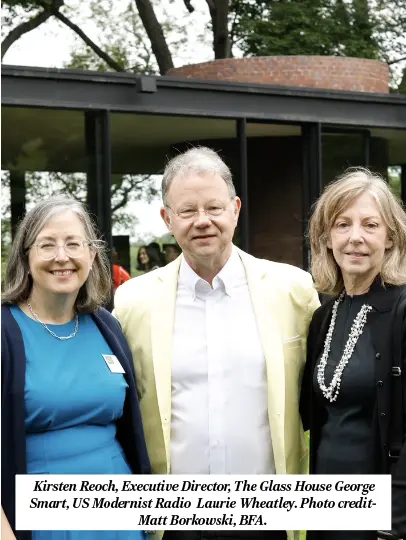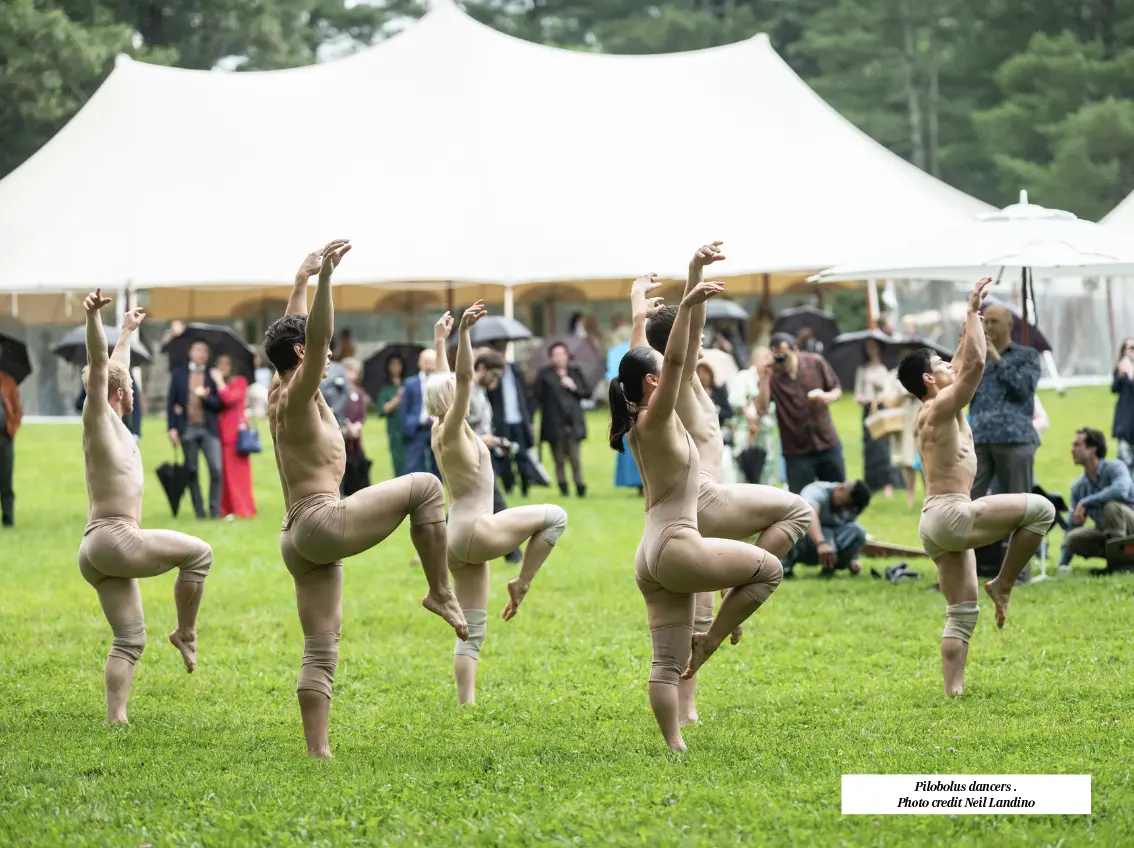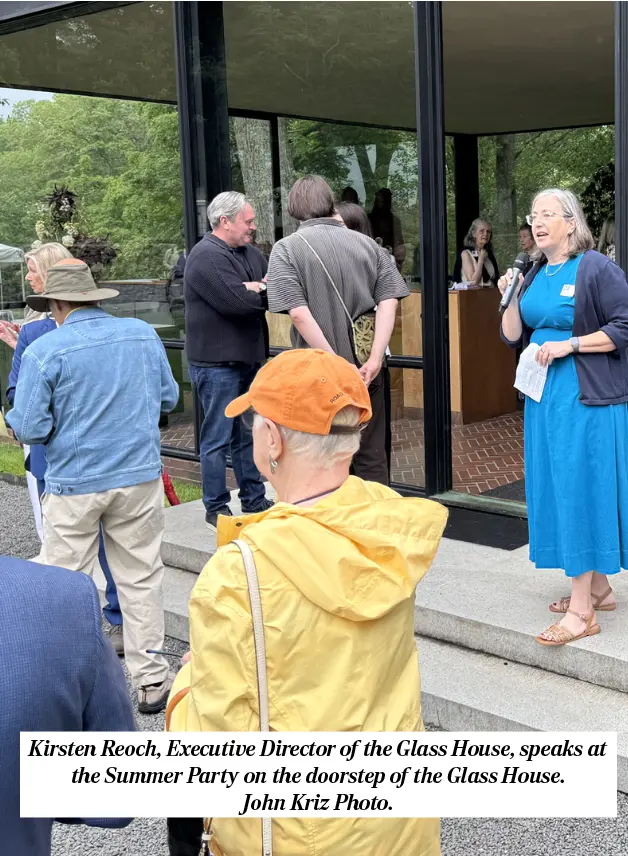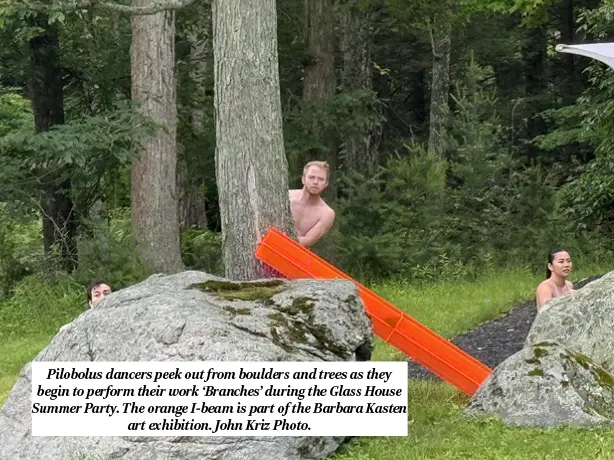By John J. Kriz
The Arrival
One of the great misnomers about New Canaan’s iconic Philip Johnson, The Glass House is embedded in the name of this historic, art-and-design-filled site: Glass House. It’s much more than that sole building, though it’s also that. Once having entered under the raised, thick silver metal tube that guards the main entrance (this tube conceals an old wooden ship’s mast inside – Mr. Johnson was creative and quirky, if nothing else) you find yourself enmeshed in an undulating vista of unique buildings, sculpture and stone walls, punctuated by meadows, gardens and wetlands seemingly under occupation by butterflies, turkeys and bobcats — a carefully curated landscape that both reveals and hides its treasures.
“This Glass House is so widely reproduced and printed that they come with just that in mind,” laments Executive Director Kirsten Reoch, “and then they are shocked to find the riches that there are to explore here. They don’t know that there are art galleries full of huge names in the arts, whether it’s Andy Warhol or Robert Rauschenberg or Frank Stella. I mean, there’s so much to see. They also are very surprised to find that the Brick House and the Glass House were built together at the same time — that truly this original footprint is two buildings here across this connected courtyard, and that this should be thought of as one composition and not one single glass house.”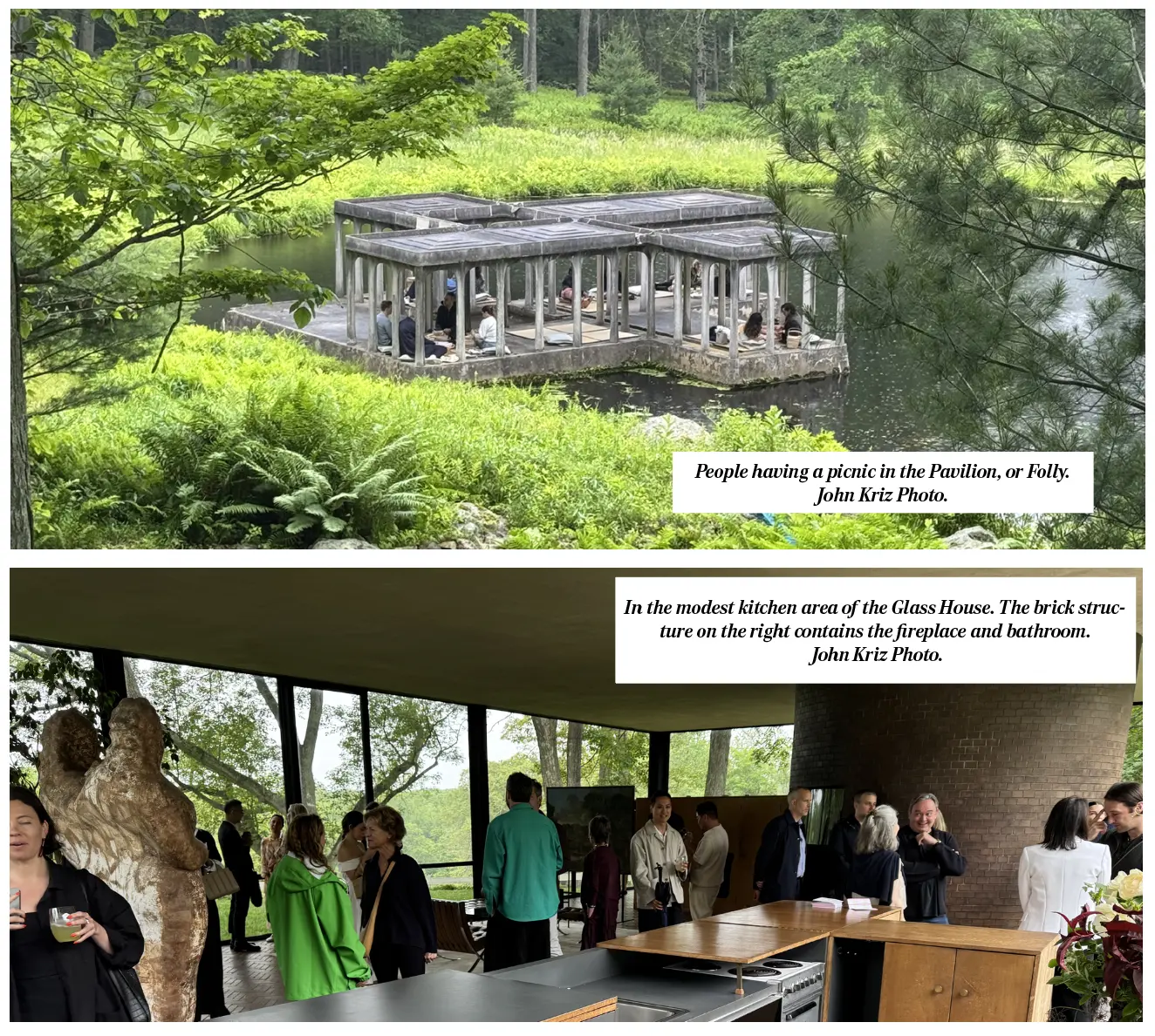
The Glass House campus www.theglasshouse.org is a National Historic Landmark situated to the northwest of West School on Ponus Ridge Road, and owned by the National Trust for Historic Preservation www.savingplaces.org. It is locally managed by its staff, whose office is across the street from New Canaan’s historic mid-1800s railway depot.
Philip Johnson
Philip Cortelyou Johnson was born in 1906, son of a wealthy lawyer. His family origins go back centuries in North America. As an example, his partial namesake, Jacques Cortelyou, was of Huguenot (French Protestant) background, who created the first map of Nieuw Amsterdam (later New York City) and assisted in the construction of a wall across lower Manhattan as protection against attacks from indigenous groups. Over time this wall transformed into Wall Street.
After completing his undergraduate studies at Harvard (later pursuing graduate architectural studies there), he developed his interest in architecture and design, helping to establish the architecture and design department at the Museum of Modern Art, becoming its curator.
In the mid/late 1930s Mr. Johnson shifted his focus, devoting himself to politics and journalism, which included pro-Nazi sympathies and anti-Semitic commentary.
According to the biography of Mr. Johnson in The Glass House’s website, fifth paragraph: “Johnson became a lightning rod for criticism, not only for his stylistic inconsistency, architectural formalism and his oft brash statements, but also for his embrace of fascist politics early in his life. While he did not appear to maintain these attitudes lifelong, he espoused pro-Nazi and American fascist sympathies during 1934-1940, which his biographer Franz Schulze referred to as the ‘inglorious detour.’ This period was bookended by Johnson’s early work at MoMA and his return to Harvard for graduate studies in architecture. Briefly working as a journalist at that time, he made statements that included not only pro-fascist attitudes but also anti-Semitic commentary. Although Johnson would attempt to distance himself from these early beliefs and statements from the 1940s on, these activities brought condemnation and criticism throughout his life.”
During the post-World War II years, Mr. Johnson’s prominence in modern architecture and design came into its own, with New Canaan becoming a center of this movement. Mr. Johnson was one of the so-called ‘Harvard Five’ Modernist architects who settled here, and they and other architects launched much of what we know today as modern architecture. As an example, dozens of modern houses were built in New Canaan, many of which remain, including a Johnson-designed, privately owned house on the east side of Ponus Ridge across from The Glass House campus. Mr. Johnson was also interested in landscape architecture, and how the land a building sits on should be integrated with the building itself.
Fast becoming one of the giants of his profession, Mr. Johnson became a sought after and trend-setting architect, helping to design such prominent structures as the AT&T Building at 550 Madison Avenue and the Lipstick Building on Third Avenue in New York City, and the Gate of Europe Towers in Madrid. A gregarious and social man, Mr. Johnson was friends with many people in the arts, hosting numerous parties at his New Canaan home.
In 1960 Mr. Johnson, who was gay, met David Whitney, an art curator and his partner for the rest of his life. The vernacular house at the far southeast corner of the property (today being the site manager’s home) was used by Mr. Whitney as his own residence, should he choose so.
Mr. Johnson died in his sleep in the Glass House in 2005, age 98. Mr. Whitney died several months later. Mr. Johnson bequeathed The Glass House property to the National Trust for Historic Preservation in 1986, with life rights of residence for him and Mr. Whitney.
The Origins
Mr. Johnson bought five acres of mostly wooded land on Ponus Ridge in New Canaan in 1946, later purchasing more, adjacent land and building a range of structures. The Glass House, Mr. Johnson’s residence for much of his life, was built along with the Brick House in 1949 – the first buildings, designed to exist symbiotically. The Brick House has the same length as the Glass House, though it’s half as deep, with Mr. Johnson’s and Mr. Whitney’s visitors using it as a guest house. It sits approximately kitty-corner from the Glass House, with a round swimming pool, built in 1955, adjacent to them.
Today, The Glass House campus is 49 acres, with 14 very distinct buildings and al fresco art installations. Major structures besides the Glass and Brick Houses include the Sculpture Gallery, Mr. Johnson’s studio/office, the Painting Gallery and several vernacular buildings highlighting his and Mr. Whitney’s interest in preservation. One such building – Grainger, circa 1783 – is the small, black-painted house on the east side of Ponus Ridge across from the main Glass House campus and just north of West School.
Preservation Challenges
Simply maintaining and operating such a complex and large site is no small, or inexpensive, task. Add in the need for major restoration of several buildings, as well as periodic ‘big ticket’ homeowner-type capital expenditures such as new roofs and heating, ventilation and cooling systems (HVAC), and the numbers get very big — fast. “Maintenance is a constant thing with a historic building. There’s no doubt,” noted Ms. Reoch.
Annual basic operating and programming costs are $3 million to $3.5 million. “We have about ten full-time staff, and then another roughly 25 to 30 seasonal staff working as educators, visitor center associates, landscaping, groundskeeping and such,” she said.
“Our assistant director of sites and maintenance…has been working here since he was seventeen. He’d started working for Philip Johnson and David Whitney towards the end of their life and he has been here ever since. He is an amazing caretaker and there’s nothing he doesn’t know about this site and about all the buildings. He really is a steward. It comes through his love of the site.”
And then there are the costs of full restorations. The Brick House, for example, was in bad shape when the National Trust took over, riddled with mold and a ceiling caving in. Costing $1.8 million to properly return it to its original glory, the Brick House only reopened last year. Said Ms. Reoch, “we had to take down, obviously, all of the drywall and interior finishes and replace all the fabrics and things like that. So you really have to start from scratch with that.” Fortunately, many of the original suppliers of carpet and fabrics were very helpful. “Fortuny in Italy made the new fabric for the walls just as they did for Johnson in the 1950s, which is amazing.” Local firm Hobbs Inc. was general contractor, and did an excellent job repairing the Italian marble in the bathroom.
“Johnson never built anything that would’ve been available through Home Depot,” emphasizes Ms. Reoch. “Everything is very custom and very finely crafted, and there’s a real artistry to his work. And that comes through, I think, in also our care of it and our maintenance.”
The Painting Gallery is another major restoration and repair example. Bermed into the hillside, with its V-shaped entrance looking a bit like an army munitions bunker, there was substantial water infiltration and humidity – not good for artwork on canvas. In 2013, all the soil over the structure had to be removed, the roof sealed tightly, and then the soil put back and reseeded. Now, the building’s HVAC is reaching the end of its natural life and needs to be replaced.
A big project that’s soon to be tackled is the lower landscape on the western side of the property, which consists of substantial wetlands, a stream, a small pond that Mr. Johnson installed, and the 1963 Pavilion, also known as the ‘Folly’ – a small art installation by the pond that looks like a columned exterior of an ancient Greek building. The Pavilion, originally clad in white concrete, has darkened over the years. As well, some of the concrete is disintegrating from exposure to the elements. The plan includes cleaning and repairing the structure, restoring the small fountains in the middle of the pinwheel-shaped structure, reinstalling lighting, and perhaps applying fresh gold leaf to the ceiling. The pond needs dredging and the shoreline of the pond has shifted, affecting the artistic juxtaposition of the Pavilion to the pond. “The stream that feeds into the pond actually needs more collection ponds so that the sediment, when there’s torrential rains, doesn’t wash into the pond and build up and allow more growth,” said Ms. Reoch.
A bit southwest of the Pavilion is a large sculpture Mr. Johnson installed to honor his friend Lincoln Kirstein, co-founder of the New York City Ballet. It needs some care, as well.
Opportunities
Perhaps the major opportunity is simply making people aware of all that The Glass House contains: not just one special building, but a collection of world-class architecture, accompanied by world-class art and sculpture. Many of these artworks are part of the permanent collection, and are not just impressive themselves, but are staged in situ, where Mr. Johnson purposely placed them, in curated juxtaposition to other rotating works, to the building in which they’re housed and to the landscape – an integrated whole.
In addition, “we change programs, change exhibitions every year,” said Ms. Reoch, these exhibitions featuring both established and emerging artists. But it’s not just ‘art for art’s sake.’ “There’s a large component of education-based mission there, as well as the curatorial,” she notes.
This year’s artist is Barbara Kasten, the title of the exhibition being ‘Structure, Light, Land.’ Her works include “photographs and sculptural installations that reorient our sense of perception and explore the dynamic relationship between space, material, and form,” according to The Glass House announcement. “Her artistic influences are deeply rooted in modernist architecture, the principles of Constructivism, and the interdisciplinary legacy of the Bauhaus, particularly the photograms of László Moholy-Nagy and Lucia Moholy.”
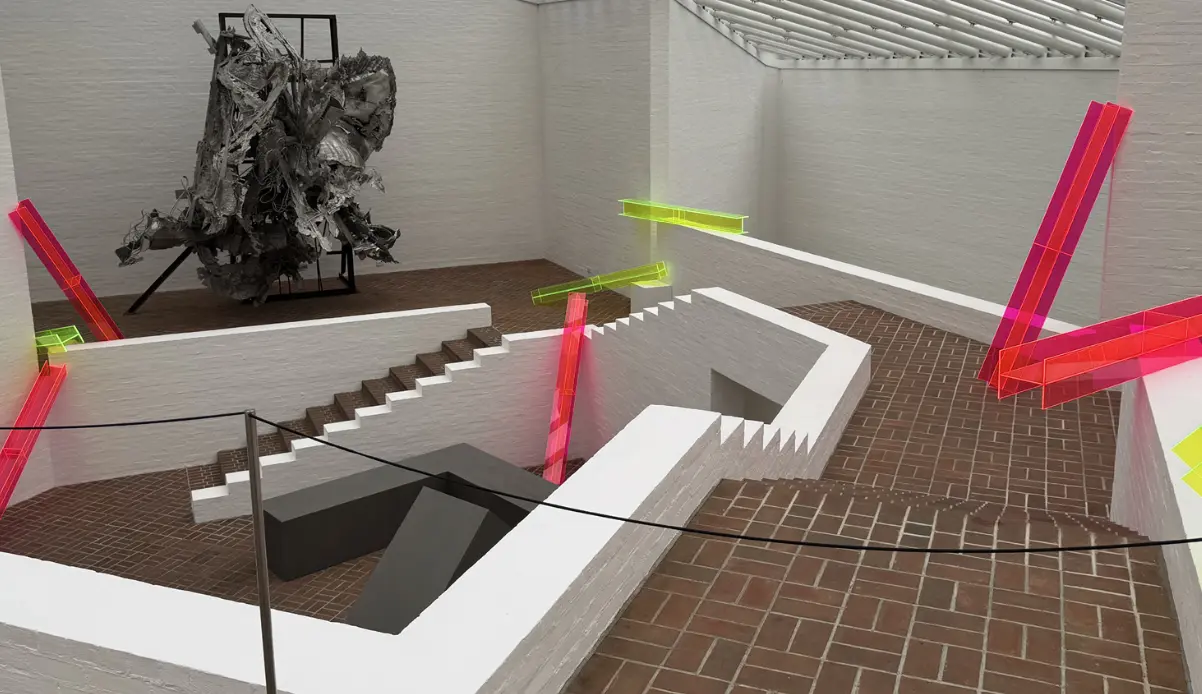
“Placing my work in and around The Glass House campus is an opportunity for me to take on a canonical modernist site. Each of the structures on the grounds is like a monument to one of many aesthetic phases of architectural history. Abstraction allows us to consider possibilities that are not the norm,” said Ms. Kasten.
In addition, there are a few occasional special programs. One program planned for later in 2025 is a talk and dinner with a prominent architect in the Painting Gallery. This is a new program, launched in 2024 with Japanese architect Shigeru Ban.
Some programs are held offsite, such as various concerts. For these, The Glass House strives to partner with other local landmarks of Modernist design, such as First Presbyterian Church in Stamford. “It is mission-driven for us to raise awareness about Modernist architecture, but also about historic preservation because the church was undergoing preservation activities and restoration. And so we wanted to amplify that,” said Ms. Reoch. She continued, stressing, “our work is more than just this site. We represent Modernism and we represent historic preservation worldwide. And so we want that voice to go out, and we want to be an advocate for others who are doing the work of restoration, and conserving significant historic sites like this.”
Another effort to ‘get the Modernist word out’ is October 4 Design www.october4design.org a New Canaan-focused celebration of art, architecture and design led by the New Canaan Museum & Historical Society, in partnership with the Town of New Canaan, The Glass House and other local groups. Events can include tours, lectures and concerts, showcasing the creative abundance that earmarks New Canaan.
It is also less well known how keen Mr. Johnson and Mr. Whitney were for landscape design and gardening. The succulent and peony gardens Mr. Whitney created still stand. “They’re just magnificent still to this day,” beamed Ms. Reoch. Mr. Johnson often said, according to Ms. Reoch, that he might have been a better landscape architect than he was an architect for buildings. The Glass House campus sports an array of landscapes: lawns, meadows, wetlands, forest glades, bridges traversing small brooks, with fieldstone walls and sharp natural slopes (it’s not called Ponus Ridge for nothing) adding further texture. Ms. Reoch is considering development of a tour specifically focused on the site’s flora and fauna. As well, The Glass House is on the Pollinator Pathway.
A new addition is a director of interpretation and education. Efforts underway include “outreach to all of the middle schools and high schools in the area,” notes Ms. Reoch, in order to expand education about the site and Modernism, as well as to boost educational visits. An anonymous supporter recently made a donation to fund that effort. In addition, with Ponus Ridge arguably being a former Native American trail, with the burial site of Chief Ponus about a mile down the road, an exploration of the Indigenous history of the site is planned.
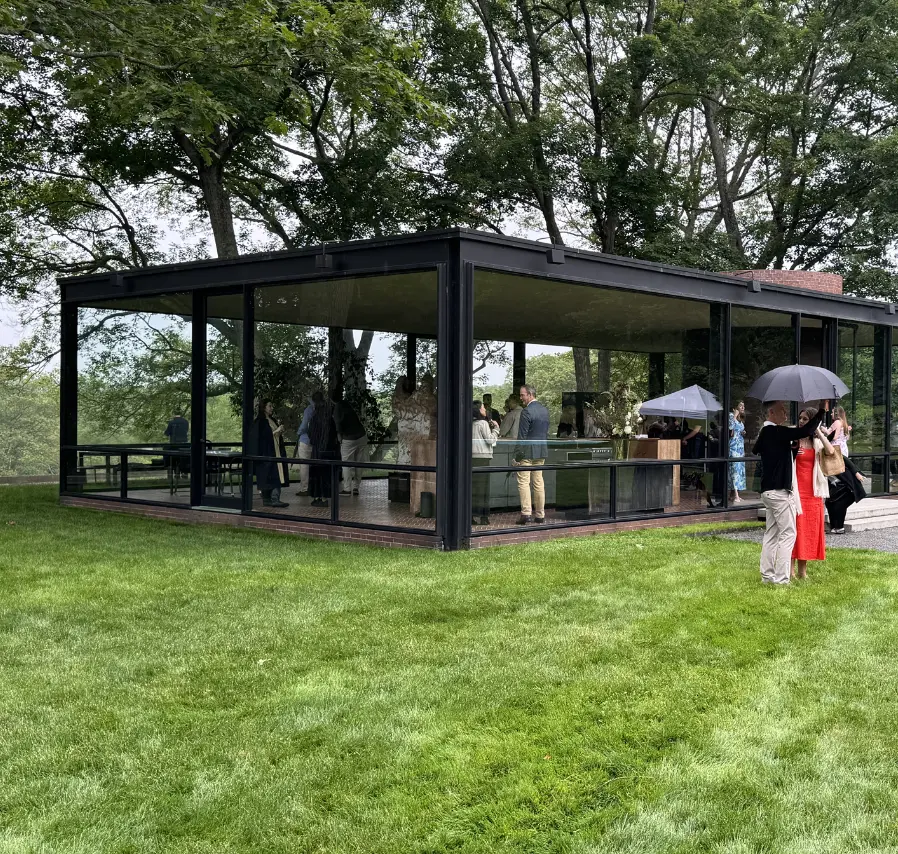
Money, Money
Fundraising is a major focus for The Glass House, as it is for any charity. Virtually all of the funds and services needed are generated by The Glass House staff’s efforts. As a practical matter, said Ms. Reoch, “we operate as an individual nonprofit with the support of a larger organization,” that being the National Trust. As noted, it takes millions every year to keep the site running and to preserve its architectural, artistic and landscape assets. And funds raised are “put back into the site, into the staff, into the programs that we feature, and into making it more accessible for the public.”
There are several funding sources: The annual Summer Party, the largest fundraising event of the year, ticket sales for tours, corporate and individual donations, an endowment from Mr. Johnson and Mr. Whitney, sales of items from the Design Store, and membership fees.
Tours occur from mid-April through mid-December, and are the second-largest source of revenue. A side benefit of these, and of the Summer Party, said Ms. Reoch, is that people from both near and far get to see New Canaan and (naturally) fall in love with it. Some even are motivated to move here. In addition, people on tours start at The Glass House’s office on Elm Street, often shopping downtown and enjoying a meal at one of New Canaan’s many restaurants. The tours are also integral to the educational aspect of The Glass House: Introducing and explaining modern architecture, and building a supportive community. Said Ms. Reoch, a tour “bridges both the mission as well as our livelihood here.” In 2024, more than 15,000 people toured the site – a record.
Tours include three different guided tours of varying lengths, a self-guided tour and a group tour. Tickets can be reserved well in advance at https://ci.ovationtix.com/419
Donations are sought as well, with two annual solicitations. There are a few big donors. The endowment helps, too. Design Store sales generate funds, and support the artists and craftspeople producing the items.
The Glass House itself and the Painting Gallery can also be rented for certain private events on a very limited basis – another funding source, albeit modest.
Membership is a new effort The Glass House development team has launched, and is designed not only to generate funds, but also promote a sense of stronger affiliation. Membership price points range from $75 to $10,000+, with each of the eight membership levels having different benefit packages. It’s still early days on this initiative, but Ms. Reoch is hopeful it will catch on.
Fundraising for major capital and restoration needs, such as the lower landscape on the western side of the property and the Pavilion, require specific capital campaigns, which are separate from fundraising for day-to-day maintenance and operations.
One major financial, program and moral support group is The Glass House’s seventeen member Advisory Council. Ms. Reoch had this to say: “They’re giving their time and they are supporting us with financial donations, and they are attending our events and they are often very well connected and notable out in the architecture and design and publishing world.” She stressed that “they’re not just a board that meets and puts in some money. They actually are doing things with us and helping our programs.”
The Summer Party
The Summer Party is quite the posh affair, with all manner of wine and cocktails, dance, special art installations, a silent auction of art, plus Max Mara merchandise. And the attendees are, shall we say, sophisticated fashionistas.
A bit of drizzle did not dampen the energy and conviviality of the attendees at this year’s party on June 14. In addition to being able to freely wander the property and its many nooks and crannies, as well as its buildings, this year’s Summer Party included a special tribute to Mr. Johnson’s friend Gaetano Pesce, an Italian architect and industrial engineer, and an exhibition of some of his works. Picnic baskets created by New Canaan’s Elm Restaurant were on offer. Pilobolus, a not-for-profit dance company based in Washington, Connecticut, provided two outdoor performances – ‘Awaken Heart’ and ‘Branches’ — utilizing The Glass House’s lawns and vistas to excellent effect.
What to Remember
What should people remember about The Glass House? Said Ms. Reoch: “I think that I would like them to gain an understanding of the later 20th century architectural forms of Modernism and Post Modernism and to see how the highest and most ideal forms of these styles then went out into the world and into the consciousness of architecture and design to this day. I’d also like them to understand what it was like for Philip Johnson and his longtime partner David Whitney to live here as partners, as people in a relationship in a glass house and in New Canaan. There’s a social history to this site that I think is really important to convey. I would also like them to go away with an understanding of what historic preservation does for our country and our culture.”
And what does historic preservation do? “It is bringing us architecture. It is bringing us art. It is bringing us together as a community. It is hiring conservators and artisans to practice their craft, and inspiring artists themselves to create new works. I think historic preservation is sometimes thought of as a very sort of static thing of ‘Save That Building’ as if you’re just putting it into a glass box. Here we get to enter and touch and talk about it, and think about how to live in these spaces. And I think that that is important for people to think of as they go home and they look at architecture and art in their communities differently. And then when historic preservation as a topic comes up, they embrace it, they champion it. Let them go away thinking historic preservation is really important to our lives and world. And then we’ve done our work.”
One Last Word: “It’s a wonderful place to have such a variety and such history of this innovation that happened at this particular time period in American architecture in one little town.”

